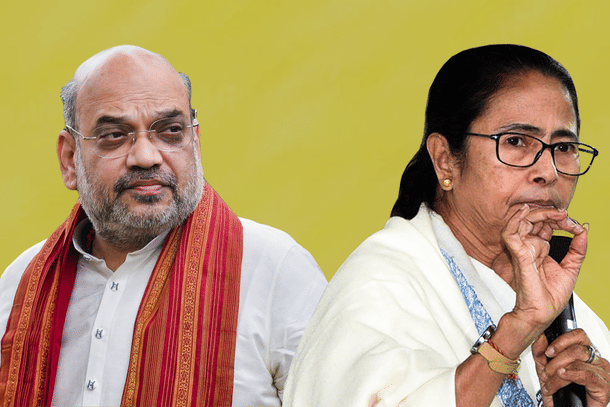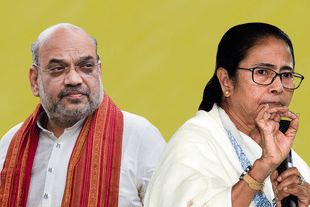Politics
The BJP Has Run Out Of Soft Options In Bengal
Suvrajyoti Gupta
May 07, 2021, 01:49 PM | Updated 01:49 PM IST
Save & read from anywhere!
Bookmark stories for easy access on any device or the Swarajya app.


The West Bengal Assembly election verdict is out, and here is how it looks: Trinamool Congress (213), Bharatiya Janata Party (77), Indian Secular Front (one) and Congress (one). To predict the future of the state, one needs to understand the communal nature of this election.
This election result can be attributed to a large and unprecedented Muslim communal consolidation behind Mamata Banerjee, and it is in this consolidation, and not her populist ‘welfare’ policies, lies the secret of BJP’s loss.
These schemes were seen by Bengali Hindus as biased, not to mention that they were second-hand copies of central schemes that Banerjee has actively blocked in the state (for instance, Sastho Sathi-Ayushman Bharat, Kanyashree-Beti Bachao etc).
Let’s look at the numbers. The percentage of vote share for Trinamool is 47.94 per cent and BJP, 38.13 per cent, with a minor dip in the saffron party’s vote share.
If we go by the general perception that the Muslim population in West Bengal is currently at 31-33 per cent, and assume that 70 per cent of the Muslims and close to 50 per cent of the Bengali Hindus need to cast their ballots for Banerjee for this result to emerge.
The problem is the BJP neither managed to deliver a ‘message’ nor managed to send a strong ‘do enough’ signal. Without that it is difficult to consolidate an identity group which in any case is in a self-denial mode.
The BJP is a Hindu party. It must be unapologetically a Hindu party and there is no need for it to establish its Bengali credo.
If Bengalis found a north-India organisation to be really ‘bohiragoto”, Communist party of India-Marxist (CPI-M) would not have ruled Bengal for 34 years.
Yet the party was defensive about its ‘Bengaliness’ and was subdued about its Hindutva messaging. It went all guns blazing against Banerjee and her allegedly corrupt party. The tone of the campaign can be sharply contrasted from that of 2019 Lok Sabha polls.
The BJP manifesto, for example, ‘Sonar Bangla Sankalpo-Patra 2021’ dedicated three pages of the 62 page document on Scheduled Caste (SC), Scheduled Tribes (ST), refugees and Other Backward Class (OBCs) with no generic talk of a Hindu.
It made perfectly ordinary promises like implementing the Citizenship Amendment Act (CAA), setting up a refugee welfare fund for the new citizens, and various schemes for SCs, STs and OBCs.
It seems like an effort to construct a theme for ‘subaltern Hinduism’ in Bengal. However, as a Bengali Hindu, it did not meet my expectations.
For the Bengali Hindu, caste is a secondary issue — the primary issue is the acknowledgement of the genocide, and uprooting in political discourse. The leftists have traditionally conditioned us to believe that the Hindu genocide did not happen, and the Bengali Hindus had to leave East Pakistan for India (present Bangladesh) because of ‘economic reasons’.
The party had an opportunity to challenge this insidious piece of leftist propaganda during the war crimes trial in Bangladesh in 2012, but could not successfully do so. It is yet to build an intellectual ecosystem in Bengal that can put up a significant challenge. This is a long term problem.
The Bengali Hindu anguish is not about the past but about the present. Infiltration in West Bengal continues unabated.
Banerjee’s so-called welfare schemes are loosely structured and corruptly disbursed through a mechanism, which are drawing the poor Muslims from across the border into India, where they create community structures, drawing more into India.
Thus, in effect, the Indian/West Bengal taxpayer is subsidising his demographic displacement.
These demographic networks are not benign — the border has many smuggling networks — which means an influx of fire arms and criminals.
Trinamool has, more than any other party, incorporated the mafia in the ‘party state’. It is party to hiding the true nature of the mafia and its demographics. That is why the West Bengal government stopped providing data to the National Criminal Records Bureau in 2018.
The BJP sporadically brought this up but failed to pivot their campaign around this. The Bengali Hindus, therefore, did not get the message. This could be partly because of the lack of a charismatic regional figure like Himanta Biswa Sarma, in Bengal.
Instead, they allowed the discourse to steer around ‘Jai Sri Ram’ which does not have the same currency or historical context among Bengali Hindus.
The BJP also failed to “do something difficult” and virtue signal to the electorate. Perhaps, notification of the CAA or starting the National Population Register (NPR) process could have achieved this, but the BJP found it too risky.
The party could have worked to identify fraudulent voters as in the case of Assam or sought action over the OBC list (99 out of the 177 communities designated as OBC in Bengal are Muslims) – or anything that would have made a difference.
One has to fire a bullet to earn the reputation of a hunter. The BJP for various reasons was unwilling to pull the trigger.
It is easy to predict that Banerjee now has greater incentive to appease and the Muslim leadership greater incentive to assert.
The election has ominously proved that the ‘imported’ demographics is its numerical power, and add to it the disunity among Bengali Hindus.
This along with the mafia power has given rise to unprecedented post poll violence.
In Nanoor of Birbhum district, more than a 1,000 Hindu families fled their homes to escape marauding mobs seeking to take it out on BJP supporters.
So far, there have been 14 causalities and counting.
Some 400 BJP karyakartas have crossed over to Assam. These incidents are not merely ‘political’ but show a sense of communal power and triumphalism that will reflected in state policies.
So far Banerjee’s chief appeasement device has been the OBC quota, which has been used to communalise the administration – the Imam bhata (dole), and a general ‘Bangladeshification’ of the Bengali Hindu culture (remove Indian authors in Bengali syllabus for Bangladeshi ones, remove Sanskrit ones for Urdu ones, organise Nabi Diwas in schools, the list goes on).
It is easy to predict that this will continue.
However, now as a result of the ‘loyalty’ the dudhelgoru (milch cow as Banerjee refers to Muslims as) will demand more which she will be happy to oblige.
Will this necessarily lead to a counter mobilisation? I would not say that is a given, unless BJP is willing to work hard.
This election has closed the soft options for BJP in Bengal. Bengal is now walking the way of Assam or Kashmir.





